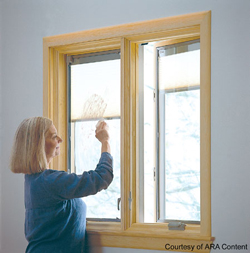 Take Precautions Now to Keep Your Family Safe at Home Take Precautions Now to Keep Your Family Safe at Home
 (ARA) - Most of us think of it as “home, sweet home.” But the alarming fact is that more than 20,000 Americans die each year due to unintentional home injuries, according to a study by the Home Safety Council. Another 20 million medical visits are attributed annually to injuries occurring in the home. Chief causes of home-related injuries and deaths include fire, poisoning, suffocation, choking, and falls. (ARA) - Most of us think of it as “home, sweet home.” But the alarming fact is that more than 20,000 Americans die each year due to unintentional home injuries, according to a study by the Home Safety Council. Another 20 million medical visits are attributed annually to injuries occurring in the home. Chief causes of home-related injuries and deaths include fire, poisoning, suffocation, choking, and falls.
How can you help alleviate the potential for accidents or injury in your home from fire or other potentially life-threatening hazards? Simply take precautions now to protect your home and most importantly, your loved ones.
First, keep smoke detectors in working order, and replace units every 10 years for maximum performance. Test batteries at least twice each year. And, make sure detectors are located on each level in key places throughout your home, including outside each bedroom.
In the event of a fire, doors are typically the primary means of escape from the home. Make sure they’re not difficult to open or blocked by clutter, which could cause a fall. To allow for a secondary escape route, make sure your windows are easy to open and not obstructed by furniture or other items. During spring and fall cleanings, check to make sure windows are easily opened from the inside and are not painted or nailed shut. If windows or doors cannot be opened quickly, it’s time for replacement to help ensure your family’s safety.
“Testing your windows and doors at least twice a year and keeping the path to them clear helps ensure that you’ll be able to safely exit your home in an emergency,” said Kathy Krafka Harkema, spokesperson for Pella Corporation. “Make sure that all windows and doors open easily, and that locks can be operated by every member of the family, to permit a quick, safe exit.”
Finally, develop a family escape plan and designate a meeting spot a safe distance outside of the home. Practice your plan often so everyone in your home is aware of how to get out safely in the event of a fire.
According to the Consumer Product Safety Commission, more than 390,000 residential fires are reported annually, and nearly 3,200 people die in home fires each year. Although flames can be deadly, many deaths and injuries related to home fires aren’t due to the fire itself. Most home fire-related deaths are actually a result of smoke inhalation.
In addition to protecting your home and family from the risk of fire and smoke, it’s also important to take precautions to prevent other hazards.
Every member of the household can suffer injuries from falls, but they often have the most detrimental impact on the elderly. Falls are most prevalent among those age 65 and older, with one in three suffering a fall each year. Twenty to 30 percent of those who experience a fall sustain moderate to severe injuries. Prevent falls by making sure frequently used pathways in the home are kept clear. Use safety strips on outdoor steps to prevent slips and falls, and be sure that all stairs, even just a couple of steps leading to the front door, have hand rails. To eliminate the hazard of tripping or slipping on area rugs, use double-sided tape to keep rugs in place.
To ensure their safety, children should be under the watchful eye of an adult in the home. Minimize the potential for accidents or injury by keeping infants and babies away from windows, especially cribs where toddlers can easily reach and climb to precarious spots. Keep windows closed and locked to lessen the potential for home-related accidents. If your home features double-hung windows, close the bottom sash nearest to children, and open the top sash to allow for ventilation. This simple step will help prevent a toddler from toppling out a window. Heed the warning of window and door manufacturers: screens are not meant to stop a child from falling.
Other potential home hazards involve those that can result in suffocation or choking. According to the National Safe Kids Campaign’s “Report to the Nation,” major causes of airway obstruction injuries include suffocation by pillows, choking on food or small objects, and strangulation from window blind and clothing strings. Adults should assess the home for potential choking or suffocation hazards, and remove those that pose the greatest risks.
The potential choking hazards posed by window fashions can be eliminated easily. When shopping for new blinds, ask your retailer for safety options, including cordless window fashions. If you are remodeling your home, leading window manufacturers even offer cordless window fashions protected between panes of glass that not only safeguard your children, but overzealous pets as well. Replace potentially hazardous cords on existing window blinds with safety tassels.
Homeowners periodically should survey their home for safety hazards. View your home from the eye level of children and pets. Many home hazards become more apparent at this lower height. Also, keep in mind how easy or difficult it would be to negotiate your home if you had difficulty walking or seeing.
“Your home is your greatest investment. Keep it, and your loved ones, safe by using common sense and investing in home safety,” Krafka Harkema said.
Courtesy of ARA ContentViews: 1 | 